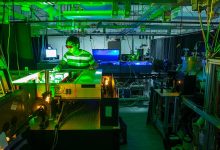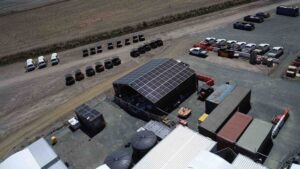Australian researchers have unlocked the secret to squeezing more energy out of sunlight, by converting otherwise wasted sunlight into useful light, that could provide a way to significantly boost to solar panel efficiencies.
The research, led by scientists from the University of New South Wales and published in the journal Nature Photonics on Tuesday, outlines a new method for ensuring more of the sun’s energy can be converted into useful electricity by using sunlight that would otherwise be wasted as heat.
In a photovoltaic solar cell, sunlight is converted into electricity through a process called the photoelectric effect, where individual packets of light, called photons, transfer their energy onto electrons within the solar cell material.
If a sufficient amount of energy is transferred by light to an electron, an amount of energy known as the “bandgap”, the electron is knocked loose from its atom and creates an electric current. This is the process by which solar panels convert light into electricity.
Not all light from the sun carries enough energy to knock electrons loose from their atoms, failing to bridge the “bandgap”, and this energy is effectively treated as an efficiency loss.
The amount of energy a packet of light can impart on an electron is proportionate to its frequency. The higher the frequency of light, the more energy the packet of light carries. Light in the infrared part of the spectrum usually lacks sufficient energy to produce electricity in a solar cell.
“The energy from the sun is not just visible light,” senior author and UNSW professor Tim Schmidt said. “The spectrum is broad, including infrared light which gives us heat and ultraviolet which can burn our skin.”
“Most solar cells are made from silicon, which cannot respond to light less energetic than the near infrared. This means that some parts of the light spectrum are going unused by many of our current devices and technologies.”

However, the researchers from the University of New South Wales have unlocked a way to combine the energy from several “low energy” light packets, into a “high energy” light packet, that can then be used to produce electricity.
By adding up the energy from a number of low energy photons, the researchers found a way to surpass the “bandgap” and use otherwise lost solar energy to produce electricity.
“One way of doing this is to capture multiple smaller energy photons of light and glue them together,” professor Schmidt adds.
“This can be done by interacting the excitons (bound states of electrons and electron holes that can transport energy without transporting net electric charge) in organic molecules.”
The researchers believe that this “upconversion” of low energy photons could be a pathway to boosting the efficiency of solar cells. While US-based researchers have demonstrated the successful combination of energy from multiple photons previously, the UNSW team have successfully demonstrated the ability to bridge the “bandgap” in silicon for the first time.
In the research paper, the scientists outline how oxygen had served as a critical intermediary material in the transfer of the sun’s energy, despite the researchers initially believing it was detrimental.
“What’s interesting is that often without oxygen, lots of things work well. And as soon as you allow oxygen in, they stop working,” contributing author Professor Jared Cole of RMIT University said. “It was the Achilles heel that ruined all our plans but now, not only have we found a way around it, suddenly it helps us.”
The researchers said that the research was still in its early stages, and further work was necessary before we will see the technique used in commercially available solar panels.
“This is only an early demonstration, and there’ quite a lot of materials development needed to make commercial solar cells, but this shows us it’s possible,” professor Schmidt added.
The breakthrough was achieved as part of a collaboration between researchers at the UNSW, RMIT University and the University of Kentucky, but the researchers are optimistic that their findings will help advance solar innovations.
“As this is the first time we’ve been successful with this method, we will face some challenges,” lead author Elham Gholizadeh of UNSW said.
“But I’m very hopeful and think that we can improve the efficiency quickly. I think it’s quite exciting for everyone. It’s a good method to use oxygen to transfer energy.”
UNSW has long been a global leader in solar efficiency records, having held the solar cell efficiency record for several decades. More recently, the university set a new world record efficiency for next generation perovskite solar cells.










